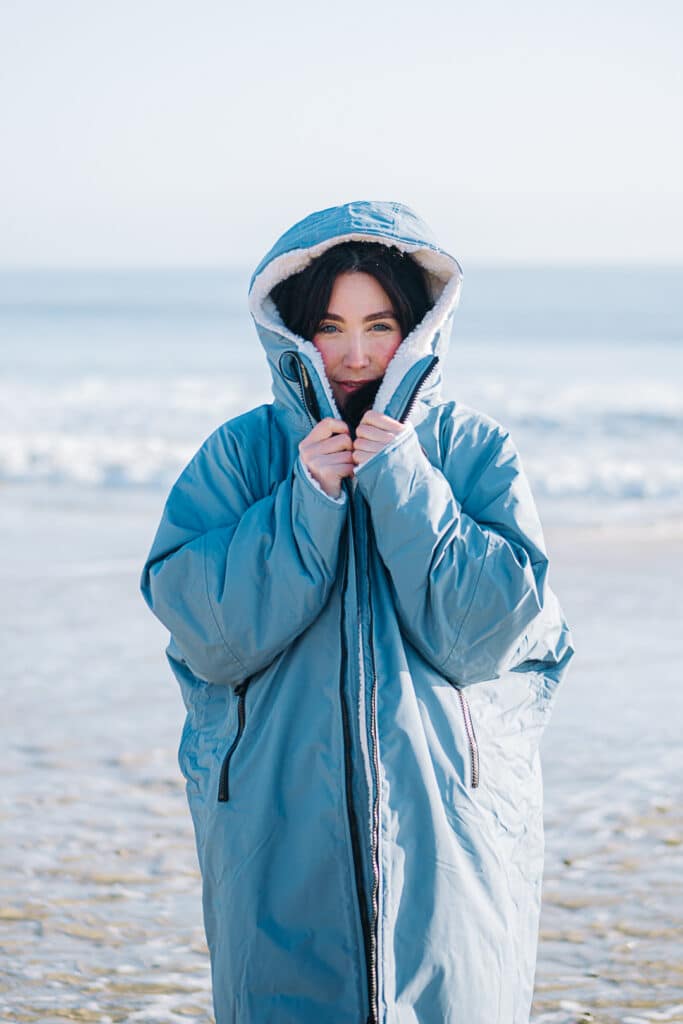Following an impromptu dip in the sea a few weeks ago, I discovered that heating up your core temperature is much harder than it looks from the outside. Despite a triple layer of t-shirt, jumper and hoodie, followed by inner fleece and outer jacket, I realised that the only way I was going to warm up would be to abandon the family, leaving them alone to fend off roaming wolf packs or any similar perils, whilst I bravely looked after number one. My only hope lay in attacking the 2 mile journey back to the car, where comforting heaters awaited.
After stomping to the top of the cliff overlooking Worbarrow Bay, I had to check myself to take in the simply majestic sunset. And also because the family I had recently abandoned had the car keys. After 10 minutes of near-hypothermic reverie my youngest daughter emerged from the (admittedly very) steep coastal path, before collapsing dramatically in a heap “Why did you bring us here, you idiot?”
I didn’t really have an answer, the sunset was saying everything I wanted to better than I ever could through chattering teeth. I guess I am just an idiot who likes nothing more than spending time outside with his loving family. And for that, I need to make sure that I’m always properly prepared.
So what are the bare wardrobe essentials for an active, outdoorsy lifestyle? And what are the golden rules when it comes to packing and preparing outdoor kit for a day out/weekend away?
I guess first rule of thumb should be; always pack more outdoor kit than you think you’ll need. Layers, hats and gloves can account for most situations you’ll encounter, but sometimes there’s no substitute for specialist equipment.

Let’s start with the most obvious of outdoor essentials; the jacket. If you’re going to invest in any one item, here’s where to start. How much should you spend? Simply put, as much as you can afford. You’re unlikely to ever find yourself in a situation where you’re saying to yourself “I really wish I’d spent less on this jacket.” Too hot? Take it off. Too cold? Move somewhere warmer. Check the waterproof and breathability ratings and try to find one that strikes a good balance between the two. Brands are a personal preference, but anything Gore-Tex is likely to be a good bet, combining excellent waterproofing and wind-stopping properties with breathability.
Next essential? Footwear. Again, no point in scrimping here. Buy the sturdiest, most comfortable, most waterproof walking boots you can afford. Weight is a sign of reliability. Boots should feel hefty enough that you’d feel confident slinging them in a sack and clubbing an attacking bear to death, should the need arise. I’ve owned the same pair of boots since 2003. That’s longer than I’ve owned my eldest child.
This might suggest that I ain’t been wearing them enough, but I have worn them exactly as much as I needed to. I have hiked up mountains, through mud, forded shallow streams, and stomped smugly and sure-footedly through deep snow, whilst others are shod in shoes suggesting they’re about to perform in a ballet recital. You can always invest in a lighter pair of trail shoes for the days when something less heavy duty is required.

Third essential? Wetsuit. Obviously if you can’t swim or have a catlike aversion to water this is probably not the wisest investment, but the value and versatility of a decent winter wetsuit can’t be underestimated. Starting at around £100, go for at least a 4 but preferably 5mm suit, and it’ll see you through a good 9 months of the British year. You may not need one during the summer (although you can pick up a cheap shortie for around £15 if needed), but again, you’re unlikely to regret having gone for the thicker option.
An all-round wetsuit can be used for so many things; surfing, bodyboarding, outdoor swimming, paddle-boarding, wind surfing, kayaking, even sailing. It’s not going to be as buoyant or flexible as a proper swimming wetsuit, but unless you’re planning on specialising in outdoor swimming or triathlon, it should do the trick.
All in all, an investment of around £300 should be enough to acquire these 3 outdoor essentials. Not cheap by any means, but there are ways to save and make money with planning and foresight. Touting your children around the village as pious, Victorian-era chimney sweeps for example. Also, investing in winter gear during the spring sales can obviously save a chunk of change. Either is a good option, so choose whatever works for you.

Elsewhere, joining the National Trust not only supports great causes and helps preserve our beautiful historical sites and buildings, but it also means you can park for free in many of the Trust’s carparks. Who among us hasn’t arrived at a site of significant historical importance before rummaging unsuccessfully under the car seats for change, then driving 5 miles to the nearest village and buying a mountain of Dorset apple cake in order to get cashback for the car park? National trust membership should fix that dilemma.
Of course, if you don’t fancy the expense right now, you could always stay indoors until the spring sales start, or wait for the 3 day window when it’s possible to swim in British waters for longer than 20 minutes without risking hypothermia, but where’s the fun in that? Winter is a glorious time to be outside in this glorious country of ours.
Outdoor Kit: The Land & Wave recommendations
Phoebe Webster – Typhoon Kona OFZ Women’s 5mm Wetsuit.

“I use this for coasteering and paddle boarding. It’s so warm, even in the Winter. The overhead front zip, makes it a bit of a struggle to get off, but the benefit is that it stops cold water flushing through.” (If only she could remember to put it on the right way!)
Vicki Cannings – EB Django Climbing Shoes

“These are great for small feet (size 4). They help me with precision footwork and are super sticky to help me grip to the wall.”
Rosie Tanner – Rab Asylum Down Jacket

“This was a Christmas present to myself. I don’t think I’ve ever felt really warm before owning this jacket. It’s great for belaying during Winter as it has internal pockets to keep your climbing shoes warm and you can unzip it from the bottom to allow space for your harness and rope.”
Paul Taylor – Adidas Terrex Swift R2 Mid GTX Shoes

“These shoes have been great for coaching days at the crag. They’re really lightweight and waterproof (even when walking across boggy terrain in Dartmoor). A lot of climbing coaching days are spent on your feet being fairly static and these have been really comfortable and warm.”
Matt Roberts – Alder Evo Fire Chest Zip Hooded Wetsuit

“This wetsuit has made my winter. It’s amazing. It’s a 6mm suit but is still easy to get on and off. You can get some really good deals on Alder wetsuits. I’m so happy with this one.”
Sophie Tanner – Rab Ascent Jacket

“I’ve had this down jacket for over 3 years now and it’s the best. I use it for work and for dog walks. It’s really warm, has a double ended zip for belaying and it packs down into a tiny bag. I go on lots of van trips, so being able to pack it away is really handy.”
Owen Senior – Scarpa Manta Boots

“I’ve had these boots for 20 years and they’ve seen me through my Uni days, seasons in Scotland, Wales and France, plus hundreds of stomps with the dogs. They weigh a tonne, and are made of seemingly bullet-proof leather – but they are an absolute joy. I’ve had them resoled a couple of times, they keep my feet warm, dry, comfortable and have plenty of life in them yet.”
12 February 2019 by Ben Lewis





